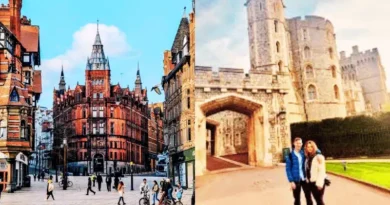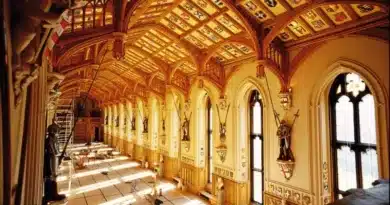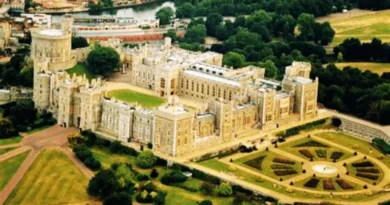The State Dining Room, Windsor Castle
Key Takeaways
| Category | Details |
|---|---|
| The Room | – Grand hall used by the Royal Family for large formal gatherings.- Rich red and gold colour scheme with ornate features.- Heavily damaged by a fire in 1992 but meticulously restored.- Rectangular layout with high ceilings and large windows. |
| Historical Significance | – Located in the Prince of Wales’s Tower, with origins dating back to King Henry VII.- Underwent transformations reflecting the tastes of different monarchs.- Most significant change came under King George IV with a Gothic Revival redesign.- Devastated by the 1992 fire but painstakingly restored to its former glory. |
| Decoration and Furnishings | – Crimson walls and gold accents create a regal atmosphere.- Extendible mahogany State Dining Table by A.C. and A.W.N. Pugin.- Upholstered chairs with intricate detailing complement the colour scheme.- Majestic crystal chandeliers illuminate the space with a warm glow. |
| The Grand Service | – Breathtaking collection of silver-gilt tableware commissioned by King George IV.- Over 4,000 pieces meticulously crafted by Rundell, Bridge & Rundell silversmiths.- Silver-gilt material creates a dazzling and luxurious appearance.- Pieces include platters, salt cellars, candelabra, and more, some with historical themes. |
| Functions | – Stage for State Banquets – pinnacle of diplomatic events hosted by the Queen.- Venue for intimate Royal Family gatherings like Christmas lunches and celebrations.- The setting reflects the formality or informality of the occasion. |
| Legacy | – Symbol of British history and tradition through its architectural evolution.- Embodies the long-standing tradition of royal state banquets.- Offers a glimpse into the public and private spheres of royal life.- A stage for grand ceremonies and rituals reinforcing the monarchy’s symbolic power. |
| Overall | The State Dining Room is more than just a dining space. It’s a testament to British history, tradition, and ongoing ceremony. It serves as a symbol of the monarchy, showcasing diplomatic grandeur and cherished family moments. |
I. Introduction
The State Dining Room at Windsor Castle is a grand hall that hosts large formal gatherings by the British Royal Family. Featuring a rich red and gold colour scheme with ornate gold panelling and ruby curtains, it was heavily damaged in a 1992 fire but has since been restored. A long table is set for events with pieces from the Grand Service, a historic collection of silver-gilt tableware.
II. The Significance of the State Dining Room
Nestled within the sprawling complex of Windsor Castle, the official residence of the British monarchs for over 1,000 years, lies the State Dining Room. This magnificent chamber transcends its function as a dining space, evolving into a potent symbol of royal power, history, and tradition. Immaculately designed and steeped in grandeur, it serves as a stage for momentous state occasions, hosting formal dinners for visiting dignitaries and heads of state and grand celebrations for the Royal Family.
The State Dining Room’s primary purpose revolves around hosting formal events of national and international significance. State Banquets, the pinnacle of state occasions, see the Queen welcoming foreign monarchs and presidents for lavish dinners that solidify diplomatic ties and celebrate historic partnerships. Beyond the realm of international relations, the room also plays a crucial role in the life of the Royal Family. It becomes the backdrop for intimate gatherings like Christmas lunches, bringing together the extended family for cherished festivities. This duality, serving state and family functions, underscores the State Dining Room’s unique position within the castle.
III. Historical Context

A. Architectural Origins: The Room’s Location and Early Design
The State Dining Room resides within the confines of the Prince of Wales’s Tower, situated at the northeast corner of Windsor Castle’s Upper Ward. Historical records suggest the room’s origins trace back to the reign of King Henry VII (r. 1485-1509), who initiated extensive renovations at the castle. While details regarding its initial design remain unclear, it likely served as a grand reception space during this period.
B. Transformations Through Time: Evolution of the State Dining Room’s Style
1. Pre-19th Century Design Influences
Over the centuries, the State Dining Room underwent various transformations, reflecting successive monarchs’ evolving tastes and architectural preferences. During the reign of Henry VIII (r. 1509-1547), the room likely adopted a Tudor style characterized by exposed timber beams and ornate fireplaces. Subsequent monarchs like Charles II (r. 1660-1685) and William III (r. 1689-1702) are believed to have favoured a more baroque aesthetic, introducing elements like rich tapestries and gilded furniture.
2. The Mark of George IV: Gothic Revival and Opulence
The most significant transformation arrived with King George IV (r. 1820-1830), a monarch renowned for extravagant tastes. In the late 1820s, he commissioned the renowned architect Jeffry Wyatville to redesign Windsor Castle comprehensively. Wyatville, a champion of the Gothic Revival style, completely revamped the State Dining Room, introducing elaborate plasterwork with Gothic motifs, pointed arches, and vibrant stained glass windows. This dramatic shift reflected a burgeoning fascination with medieval aesthetics and a desire to imbue the castle with historical grandeur.
IV. A Room Reborn: The Aftermath of the 1992 Fire

A. Devastation and Loss: The Fire’s Impact on the State Dining Room
Windsor Castle witnessed a devastating fire on a fateful day in November 1992. Originating in the Queen’s private chapel, the blaze quickly spread, engulfing neighbouring sections, including St George’s Hall and the State Apartments. The fire raged for over 15 hours, causing extensive damage to over 115 rooms. The State Dining Room, unfortunately, bore the brunt of the destruction.
The fire’s ferocious heat ravaged the elaborate plasterwork meticulously crafted during George IV’s reign. Intricate Gothic details were reduced to smouldering debris, and the once vibrant colours faded into a haunting char. Furniture and furnishings, while fortunately escaping major damage, stood amidst the wreckage, a stark reminder of the room’s former glory.
B. The Long Road to Recovery: Restoration Efforts and Challenges
The aftermath of the fire demanded a monumental restoration effort. A team of skilled conservators, architects, and craftspeople embarked on a meticulous five-year project. The primary challenge lay in recreating the intricate lost plasterwork. Historical records, photographs, and surviving fragments were crucial guides in this painstaking process. Traditional techniques like lime plastering were employed to ensure authenticity.
Beyond structural restoration, recreating the room’s opulent furnishings presented another hurdle. Thankfully, the original furniture, designed by A.C. and A.W.N. Pugin, miraculously survived the fire. However, the 19th-century sideboard, a magnificent piece crafted from rosewood and oak, was lost to the flames. Using only photographs and descriptions, skilled craftsmen were tasked with replicating this irreplaceable piece, ensuring the room retained its historical integrity.
V. Design and Décor: A Feast for the Eyes
The meticulously restored State Dining Room is a testament to the enduring legacy of British craftsmanship and royal tradition. Stepping into this grand chamber is akin to entering a scene from a bygone era, where every element contributes to a breathtaking display of luxury and historical significance.
A. A Grand Setting: The Overall Layout and Architectural Features
The State Dining Room boasts a rectangular layout, maximizing its capacity for hosting large gatherings. Towering windows on one side bathe the space in natural light. At the same time, intricate plasterwork adorns the high ceilings, a recreation of the original Gothic Revival design championed by George IV. Arched doorways lead to adjoining rooms, adding a sense of grandeur and allowing for a seamless flow of guests during formal events.
B. Color Scheme and Adornment: Reds, Golds, and Exquisite Detailing
1. Walls and Ceilings: A Canvas for Richness
The room’s colour scheme is pivotal in establishing its regal atmosphere. Deep crimson hues dominate the walls, a powerful colour traditionally associated with royalty and grandeur. This rich base is further accentuated by the liberal use of gold throughout the space. Golden accents gleam from the intricate plasterwork on the ceilings, adding a touch of opulence and reflecting the flickering candlelight during formal dinners.
2. Furnishings: A Legacy of Craftsmanship
The meticulously restored furniture within the State Dining Room stands as a testament to the exceptional skills of 19th-century British craftsmen.
- The Grand Table: The magnificent State Dining Table is the heart of the room, a rectangular masterpiece crafted from gleaming mahogany. Designed by A.C. and A.W.N. Pugin, it can be extended to accommodate up to 160 guests, transforming the space into a stage for grand diplomatic gatherings.
- Seating fit for Royalty: Upholstered chairs, specifically designed for the room, flank the table on either side. The deep crimson upholstery complements the wall colour, while intricate gold detailing on the frames echoes the overall colour scheme. These chairs are not mere furniture pieces but are designed for comfort and posture, ensuring esteemed guests enjoy the lavish meals served during state banquets.
- Illuminating Grandeur: The State Dining Room’s brilliance is further accentuated by its spectacular lighting scheme. Majestic crystal chandeliers adorned with hundreds of glittering pendants hang from the high ceilings. The multifaceted crystals refract the candlelight, casting a warm and inviting glow over the room. This interplay of light and shadow amplifies the sense of grandeur and creates a truly breathtaking atmosphere.
VI. The Grand Service: A Table Setting Steeped in History

A. Commissioned by a King: The Origins of the Grand Service
The State Dining Room’s grandeur extends beyond its architectural magnificence. The table becomes a stage for the Grand Service, a breathtaking collection of silver-gilt tableware commissioned by King George IV in the early 19th century.
Driven by his desire for opulence and a yearning to rival the grandeur of European royal courts, George IV embarked on an ambitious project to create a truly exceptional tableware collection. He entrusted the renowned silversmiths Rundell, Bridge & Rundell with crafting an extensive service for use during state banquets and other formal occasions.
B. A Dazzling Display: Components of the Grand Service
Comprised of over 4,000 pieces, the Grand Service is a remarkable feat of craftsmanship and artistic design. It encompasses many items, each meticulously crafted from silver gilt. Silver is coated with a thin layer of gold in this luxurious material, creating a dazzling and regal appearance.
1. Silver Gilt: Crafting a Royal Tableware Collection
The silver used in the Grand Service is of the highest quality. Skilled silversmiths meticulously worked the metal, hammering it into shape and employing various techniques like chasing, repoussé, and engraving to create intricate details and ornate patterns. The final step involved applying a thin layer of gold, transforming the silver into a shimmering and luxurious material worthy of a royal table.
2. Exquisite Design: Pieces with Historical Significance
The Grand Service boasts a dazzling array of pieces, each serving a specific purpose during a formal dinner. The collection caters to every aspect of a lavish banquet, from grand platters for displaying the main course to delicate salt cellars and ornate candelabra. Many pieces are adorned with intricate designs and motifs, some reflecting historical themes or referencing the Royal Arms. This dedication to detail elevates the Grand Service beyond mere tableware, transforming it into a collection with historical and artistic significance.
VII. The State Dining Room in Use: A Stage for Grand Occasions

The State Dining Room transcends its architectural beauty to become a dynamic space pulsating with history and tradition. It transforms into a stage for momentous events, serving as a backdrop for grand diplomatic gatherings and intimate royal family celebrations.
A. State Banquets and Diplomatic Gatherings
The State Dining Room finds its most formal use during State Banquets, the pinnacle of diplomatic events hosted by the Queen. These lavish dinners solidify international relations, foster partnerships, and celebrate historic moments between nations.
When a foreign monarch or head of state arrives on a state visit, a grand banquet is usually hosted in their honour. The State Dining Table is adorned with the magnificent Grand Service, each piece gleaming under the soft glow of crystal chandeliers. As the head of state, the Queen sits at the centre of the table, with the visiting dignitary opposite her. The meticulously planned menu showcases the best of British cuisine, further adding to the sense of occasion.
Beyond the sumptuous meal, the State Dining Room becomes a platform for important discussions and diplomatic exchanges. The intimate setting fosters dialogue and camaraderie, crucial in international relations.
B. Royal Family Events: Christmas Lunches and Celebrations
While the State Dining Room serves as a stage for international grandeur, it also plays a more intimate role within the Royal Family. The space transforms into a warm and welcoming venue for cherished family gatherings.
The Queen hosts a traditional Christmas Lunch for the extended Royal Family every Christmas. The grand table is adorned with festive decorations, creating a joyful atmosphere. The formality of state banquets gives way to a more relaxed yet elegant setting where the family comes together to celebrate the holidays.
Beyond Christmas, the State Dining Room may host other family occasions like birthday celebrations or christenings. In these instances, the room’s grandeur is softened with personal warmth, highlighting its versatility and significance within the Royal Family.
VIII. Enduring Legacy: The State Dining Room’s Significance
The State Dining Room at Windsor Castle transcends its function as a mere dining space. It stands as a powerful symbol of history, tradition, and the enduring legacy of the British monarchy.
A. A Symbol of History and Tradition
The room’s architectural evolution reflects successive monarchs’ changing tastes and priorities. From the early Tudor style to the opulent Gothic Revival championed by George IV, the State Dining Room becomes a tangible timeline, chronicling the architectural and artistic movements that have shaped British history.
Moreover, the room embodies the long-standing tradition of royal state banquets dating back centuries. These lavish dinners solidify diplomatic ties and celebrate historic partnerships, ensuring the continuation of a tradition woven into the fabric of British international relations.
B. A Window into Royal Life and Ceremony
The State Dining Room offers a unique glimpse into the world of the British Royal Family. While primarily used for formal occasions, it also hosts intimate family gatherings, revealing a more personal side of royalty. This duality allows the room to bridge royal life’s public and private spheres.
Furthermore, the State Dining Room is a grand ceremony and ritual stage. The meticulous table settings, the dazzling Grand Service, and the carefully curated menus all contribute to a sense of grandeur and tradition. These elements combine to create a captivating spectacle that reinforces the symbolic power of the monarchy.
In conclusion, the State Dining Room at Windsor Castle is more than just a beautifully adorned space. It embodies a rich tapestry of history, tradition, and ongoing ceremony. It is a powerful symbol of the British monarchy, offering a glimpse into a world of diplomatic grandeur and cherished family gatherings. As the Royal Family continues to host events within its walls, the State Dining Room ensures the legacy of British tradition endures for generations to come.
FAQ
What is the history of the State Dining Room at Windsor Castle?
The State Dining Room, located in the Prince of Wales’s Tower at the north-east corner of the Upper Ward, was among the most seriously damaged rooms during the 1992 fire at Windsor Castle. It was subsequently restored to its former glory, maintaining its historical significance within the castle.
Who was responsible for the design of the State Dining Room?
The original design of the State Dining Room is attributed to architect James Wyatt, who was appointed by George III in 1796 as Surveyor General of the Office of Works to transform the exterior of the Castle into a Gothic palace.
What architectural style characterises the State Dining Room?
The State Dining Room reflects the Gothic architectural style, a design choice made during the reign of George III and implemented by James Wyatt.
What notable artworks are displayed in the State Dining Room?
The State Dining Room houses significant artworks, including a painting by Sir Thomas Lawrence.
How was the State Dining Room affected by the 1992 Windsor Castle fire?
The State Dining Room was among the most seriously damaged rooms during the 1992 fire. It underwent extensive restoration to return it to its former splendour.
Is the State Dining Room open to the public during visits to Windsor Castle?
The State Dining Room is part of the State Apartments, which are open to the public. However, access can be subject to change due to official events or restoration work. It’s advisable to check the Royal Collection Trust’s official website for the most current visitor information.
What is the seating capacity of the State Dining Room during formal events?
The State Dining Room is designed for more intimate gatherings than larger halls like St George’s Hall, which can seat up to 160 guests. The exact seating capacity of the State Dining Room varies depending on the arrangement and nature of the event.
What role does the State Dining Room play in royal ceremonies and events?
The State Dining Room is used for formal dinners and receptions, hosting dignitaries and guests during state visits and significant royal occasions.
How does the State Dining Room compare to other dining areas within Windsor Castle?
While the State Dining Room is used for formal events, other areas like St George’s Hall are utilised for larger state banquets. Each room serves a specific purpose, reflecting the grandeur and tradition of the monarchy.
What are some unique features of the State Dining Room’s interior design?
The State Dining Room boasts Gothic architectural elements, intricate woodwork, and historic artworks, contributing to its elegant and regal atmosphere.










Comments are closed.